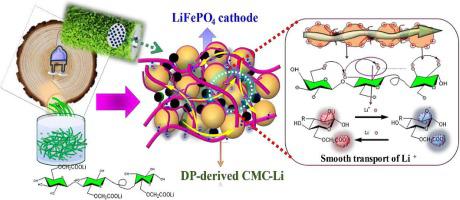当前位置:
X-MOL 学术
›
Bioresource Technol.
›
论文详情
Our official English website, www.x-mol.net, welcomes your
feedback! (Note: you will need to create a separate account there.)
Direct synthesis of a lithium carboxymethyl cellulose binder using wood dissolving pulp for high-performance LiFePO4 cathodes in lithium-ion batteries
Bioresource Technology ( IF 9.7 ) Pub Date : 2024-04-17 , DOI: 10.1016/j.biortech.2024.130711
Jingxin Li 1 , Ailin Wang 1 , Weihao Xiang 1 , Shiwei Liu 1 , Lu Li 1 , Qiong Wu 1 , Yue Liu 1 , Yuxiang Liu 1 , Genkuo Nie 1 , Shuangxi Nie 2 , Shuangquan Yao 2 , Hailong Yu 3
Bioresource Technology ( IF 9.7 ) Pub Date : 2024-04-17 , DOI: 10.1016/j.biortech.2024.130711
Jingxin Li 1 , Ailin Wang 1 , Weihao Xiang 1 , Shiwei Liu 1 , Lu Li 1 , Qiong Wu 1 , Yue Liu 1 , Yuxiang Liu 1 , Genkuo Nie 1 , Shuangxi Nie 2 , Shuangquan Yao 2 , Hailong Yu 3
Affiliation

|
Lithium carboxymethyl cellulose (CMC-Li) is a promising novel water-based binder for lithium-ion batteries. The direct synthesis of CMC-Li was innovatively developed using abundant wood dissolving pulp materials from hardwood (HW) and softwood (SW). The resulting CMC-Li-HW and CMC-Li-SW binders possessed a suitable degree of substitutions and excellent molecular weight distributions with an appropriate quantity of long- and short-chain celluloses, which facilitated the construction of a reinforced concrete-like bonding system. When used as cathode binders in LiFePO batteries, they uniformly coated and dispersed the electrode materials, formed a compact and stable conductive network with high mechanical strength and showed sufficient lithium replenishment. The prepared LiFePO batteries exhibited good mechanical stability, low charge transfer impedance, high initial discharge capacity (∼180 mAh/g), high initial Coulombic efficiency (99 %), excellent cycling performance (<3% loss over 200 cycles) and good rate capability, thereby outperforming CMC-Na and the widely used cathode binder polyvinylidene fluoride.
中文翻译:

利用木材溶解浆直接合成羧甲基纤维素锂粘合剂,用于锂离子电池高性能 LiFePO4 正极
羧甲基纤维素锂(CMC-Li)是一种有前途的新型水基锂离子电池粘合剂。 CMC-Li的直接合成是利用来自硬木(HW)和软木(SW)的丰富的木材溶解浆材料创新开发的。所得的CMC-Li-HW和CMC-Li-SW粘合剂具有合适的取代度和优异的分子量分布以及适量的长链和短链纤维素,有利于构建类似钢筋混凝土的粘合体系。当用作LiFePO电池的正极粘合剂时,它们均匀地涂覆和分散电极材料,形成致密稳定的导电网络,机械强度高,并表现出充足的锂补充。所制备的LiFePO电池表现出良好的机械稳定性、低电荷转移阻抗、高初始放电容量(∼180 mAh/g)、高初始库仑效率(99%)、优异的循环性能(200次循环损失<3%)和良好的倍率能力,从而优于 CMC-Na 和广泛使用的阴极粘合剂聚偏二氟乙烯。
更新日期:2024-04-17
中文翻译:

利用木材溶解浆直接合成羧甲基纤维素锂粘合剂,用于锂离子电池高性能 LiFePO4 正极
羧甲基纤维素锂(CMC-Li)是一种有前途的新型水基锂离子电池粘合剂。 CMC-Li的直接合成是利用来自硬木(HW)和软木(SW)的丰富的木材溶解浆材料创新开发的。所得的CMC-Li-HW和CMC-Li-SW粘合剂具有合适的取代度和优异的分子量分布以及适量的长链和短链纤维素,有利于构建类似钢筋混凝土的粘合体系。当用作LiFePO电池的正极粘合剂时,它们均匀地涂覆和分散电极材料,形成致密稳定的导电网络,机械强度高,并表现出充足的锂补充。所制备的LiFePO电池表现出良好的机械稳定性、低电荷转移阻抗、高初始放电容量(∼180 mAh/g)、高初始库仑效率(99%)、优异的循环性能(200次循环损失<3%)和良好的倍率能力,从而优于 CMC-Na 和广泛使用的阴极粘合剂聚偏二氟乙烯。

































 京公网安备 11010802027423号
京公网安备 11010802027423号